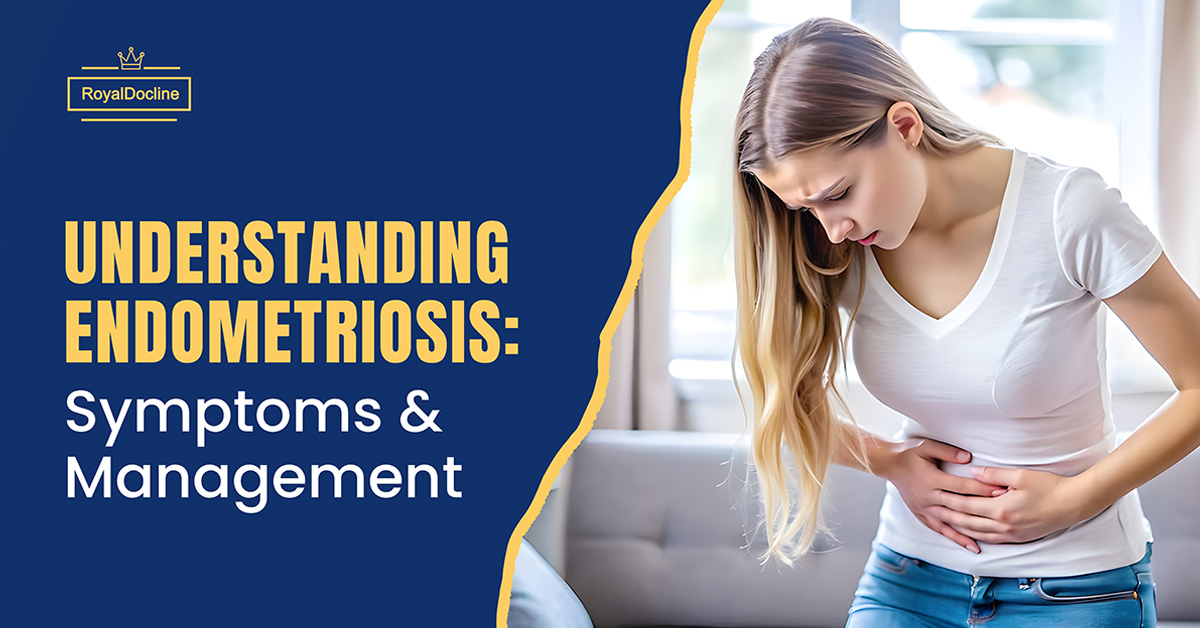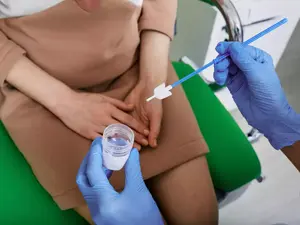
While endometriosis is not life-threatening, it can significantly affect your daily life. It can lead to chronic pain, irregular periods, and fertility issues. Millions of women around the world are living with endometriosis, but many aren’t diagnosed for years because the symptoms are often misunderstood or overlooked. Endometriosis is much more than just “bad cramps.”
Signs and Symptoms of Endometriosis
The symptoms of endometriosis can vary widely. Some women experience severe pain and discomfort, while others may not have any noticeable symptoms. This makes it difficult to diagnose early. Below are some common signs and symptoms:
Pelvic Pain
This is the most common symptom of endometriosis. Unlike normal period cramps, the pain can be more intense and last longer. It may start before your period and continue throughout or even after. Pain may also occur during ovulation or at other points in the menstrual cycle.
Heavy Menstrual Periods
If you notice that your periods are unusually heavy or you experience bleeding between periods, it might be a sign of endometriosis.
Painful Intercourse
Many women with endometriosis experience pain during or after sex. This is because the misplaced tissue can become irritated during intercourse, leading to discomfort or even sharp pain.
Painful Bowel Movements or Urination
Endometriosis can affect the organs surrounding the uterus. Pain while going to the bathroom, particularly during your period, could indicate endometriosis.
Infertility
Some women discover they have endometriosis while trying to get pregnant. Difficulty conceiving is a common symptom of the condition.
Other Symptoms
Fatigue, bloating, and nausea are less specific but also common in women with endometriosis. These can sometimes be mistaken for other conditions, adding to the difficulty in diagnosing endometriosis early on.
The severity of your symptoms does not always match how advanced your endometriosis is. Women with mild endometriosis can experience severe pain, while others with more extensive growths might not feel much discomfort. It’s important to consult a healthcare provider if you experience any of these symptoms.
Common Myths About Endometriosis
There are many myths about endometriosis that can lead to confusion or misdiagnosis. Let’s clear up some common misconceptions:
Myth 1: Endometriosis is just really bad period cramps.
Many people think that women with endometriosis are just exaggerating their period pain. But this is far from the truth. The pain caused by endometriosis is not limited to menstrual cramps. It can be constant, affect different body areas, especially the lower abdomen, and lead to severe discomfort that negatively impacts daily life.
Myth 2: Pregnancy cures endometriosis.
This myth persists, but pregnancy is not a cure for endometriosis. Some women may experience symptom relief during pregnancy due to hormonal changes, but this is usually temporary. After giving birth, symptoms can return and, in some cases, even worsen.
Myth 3: You need to have symptoms to have endometriosis.
Some women with endometriosis do not experience noticeable symptoms. They might only discover they have the condition when they face challenges with fertility or undergo surgery for another issue.
Myth 4: Endometriosis only affects older women.
Endometriosis can affect women of any reproductive age, including teenagers. In fact, many women report experiencing symptoms in their teens but often have their pain dismissed or misdiagnosed.
Understanding these myths helps in raising awareness and encourages women to seek medical attention earlier rather than downplaying their symptoms. Awareness is key to reducing the delay in diagnosis, which often averages seven to ten years.
How is Endometriosis Diagnosed?
Diagnosing endometriosis is not always straightforward. The symptoms can be similar to those of other conditions like pelvic inflammatory disease (PID), irritable bowel syndrome (IBS), or ovarian cysts. Because of this, many women experience a delay in getting an accurate diagnosis. While no single test can diagnose endometriosis, the following procedures are commonly used to help identify it:
Pelvic Exam
During a pelvic exam, your doctor may feel for abnormal growths, cysts, or scar tissue around the reproductive organs. However, smaller patches of endometriosis may not be detectable during this exam alone.
Ultrasound
This imaging test can detect cysts related to endometriosis, but it won’t reveal all types of endometrial growths. A transvaginal ultrasound can provide a more detailed view of the pelvic area.
MRI (Magnetic Resonance Imaging)
An MRI scan offers a detailed look at the reproductive organs and can help doctors identify endometrial growths. This is a non-invasive test and is often recommended if surgery is being considered.
Laparoscopy
Laparoscopy is the only way to definitively diagnose endometriosis. It’s a minimally invasive surgery where a small camera is inserted into the pelvis to look for endometrial tissue. During this procedure, your surgeon can also remove endometrial growths, which can provide symptom relief.
Because of the variability in symptoms and their overlap with other conditions, it’s essential to work closely with a healthcare provider to rule out other causes and get an accurate diagnosis.
How is Endometriosis Treated?
While there is no cure for endometriosis, many treatment options can help manage symptoms and improve quality of life. The best approach depends on the severity of your symptoms, your age, and whether you plan to have children.
- Pain Relievers
Over-the-counter pain medications like ibuprofen can be helpful for managing mild discomfort. However, these won’t be effective for everyone, especially those with more severe symptoms.
2. Hormonal Therapy
Hormone-based treatments are often recommended to control or reduce the growth of endometrial tissue. These therapies aim to regulate hormone levels or stop menstruation altogether. Options include:
- Birth Control Pills, Patches, or Rings: These can regulate your periods and reduce pain.
- Gn-RH Agonists: These medications induce temporary menopause, helping to shrink endometrial tissue.
- Progestin Therapy: Progestin-based medications help slow the growth of endometrial tissue.
Surgery
If hormonal treatments don’t provide relief or if you’re trying to conceive, surgery might be necessary. Laparoscopic surgery allows for the removal of endometrial growths, scar tissue, and adhesions. In severe cases, a hysterectomy may be considered, though this is usually seen as a last resort.
-
- Fertility Treatment
For women who are struggling to conceive due to endometriosis, fertility treatments like in-vitro fertilization (IVF) may be recommended. Early intervention is often crucial for those who wish to preserve their fertility.
Each treatment plan is unique and should be discussed with your healthcare provider. Some women may need a combination of therapies for the best results.
Lifestyle Changes to Manage Endometriosis
Along with medical treatments, making certain lifestyle changes can help manage endometriosis more effectively. These changes can reduce inflammation, boost overall health, and make the symptoms easier to handle.
-
- Omega-3 fatty acids: These are found in foods like salmon, flaxseeds, and walnuts. Omega-3s have anti-inflammatory properties that may help reduce pain and inflammation associated with endometriosis.
- Fruits and Vegetables: These are high in antioxidants and can help combat oxidative stress. Including a variety of fruits and veggies in your diet may help manage symptoms.
- Whole Grains: Whole grains like oats, brown rice, and quinoa are fiber-rich and help reduce inflammation.
- Avoid or limit foods that may worsen inflammation, like red meat and processed foods. Some studies have found that a diet high in red meat and trans fats is linked to increased endometriosis risk.
- Dietary Changes
Studies suggest that certain foods can influence inflammation and hormone levels. Focus on a diet rich in:
-
- Exercise
Regular physical activity can help alleviate some of the pain associated with endometriosis. Exercise releases endorphins, which are natural pain relievers. It may also help regulate estrogen levels, which can reduce the severity of symptoms. Try incorporating low-impact exercises like walking, swimming, or yoga into your routine.
-
- Stress Management
Chronic stress can make endometriosis symptoms worse. Managing stress through activities like meditation, yoga, or deep breathing exercises can help. Setting aside time each day to unwind can make a big difference in how you feel.
-
- Heat Therapy
Applying heat to the pelvic area can significantly relieve cramps and pain. A heating pad or warm bath can also relax tense muscles and reduce discomfort.
-
- Sleep and Rest
Fatigue is a common issue for women with endometriosis. Ensuring you get enough sleep each night and allowing yourself time to rest when needed is important. If pain or discomfort is affecting your sleep, speak to your doctor about additional pain management strategies.
-
- Support System
Dealing with a chronic condition like endometriosis can feel isolating. Joining a support group or talking with others who understand your experience can help. Having a network of friends, family, or peers to turn to can boost emotional well-being.
In Conclusion
Endometriosis is a challenging condition that affects millions of women around the world. The good news is that with proper diagnosis, medical treatments, and lifestyle changes, it’s possible to manage the symptoms and live a fulfilling life.
If you think that you have endometriosis or are struggling to manage the condition, it’s important to seek help. At Royal Docline, we offer telehealth services for OB/GYN-related issues, including endometriosis. Our team of professionals is here to support you, answer your questions, and guide you through your treatment options.
Remember, you’re not alone in this. By taking control of your health and seeking the right care, you can improve your quality of life and regain control over your well-being.

